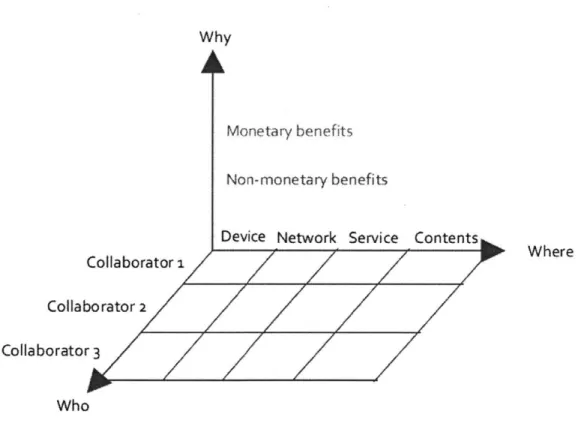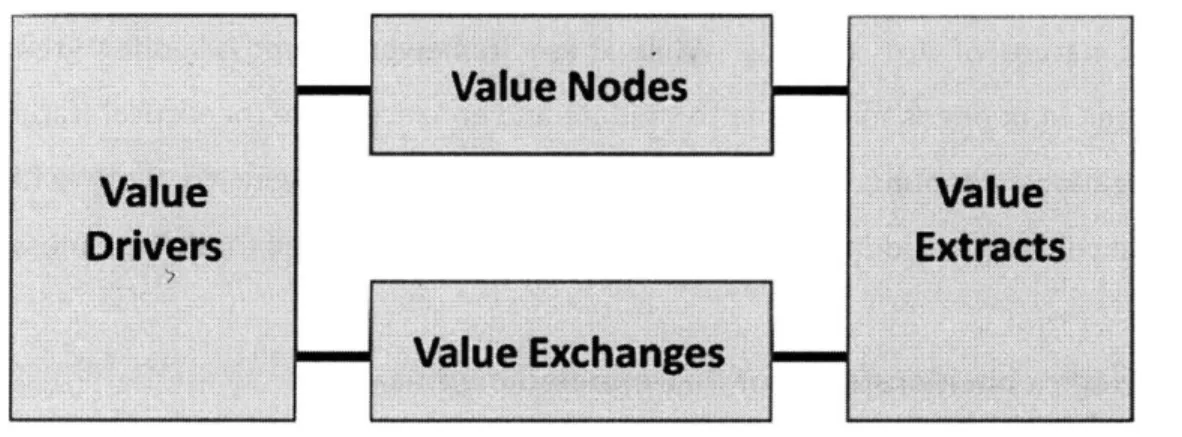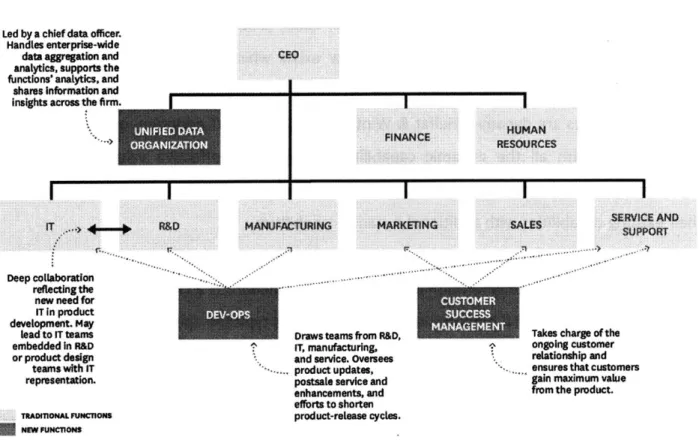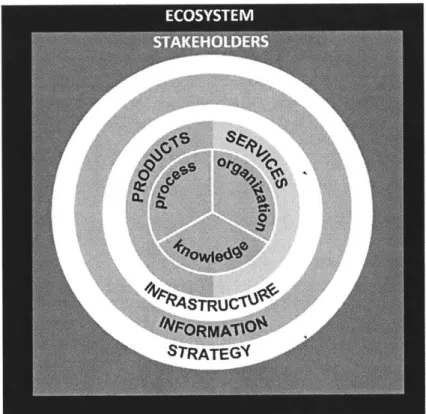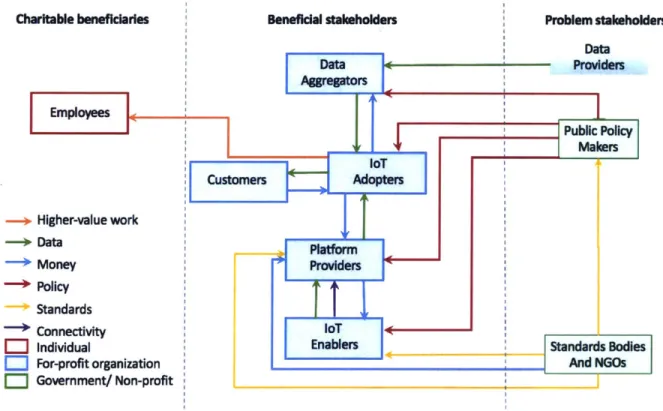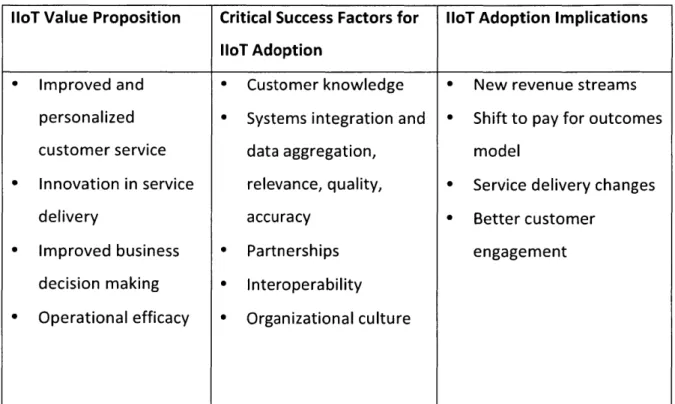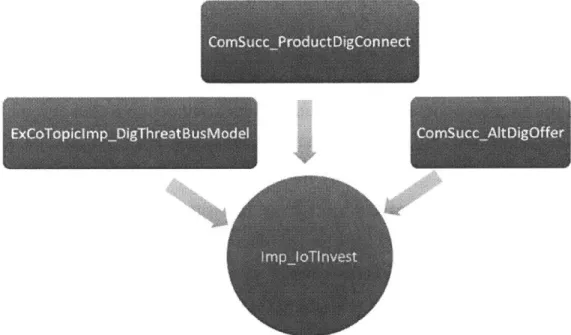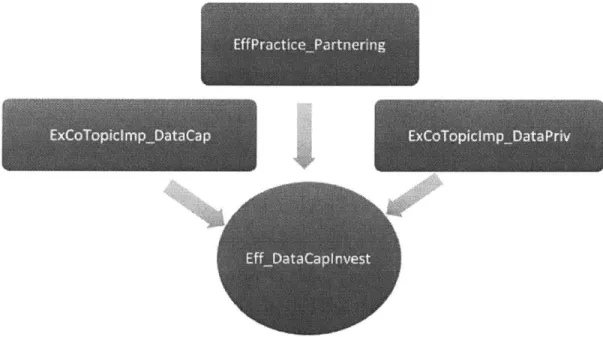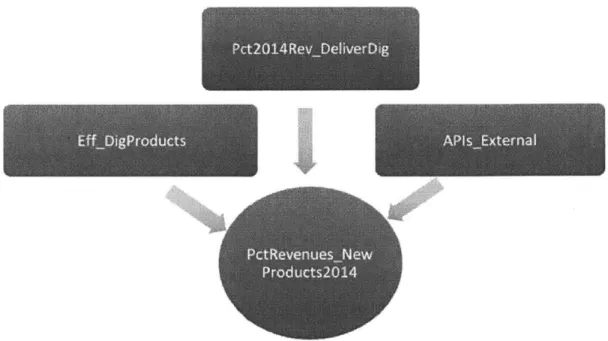Analysis of the Current State of Industrial Internet of Things (HoT)
Adoption
by
Darshini Thiagarajan
Bachelor of Science (Honours) in Business Information Technology Southampton Solent University, 2006
SUBMITTED TO THE SYSTEM DESIGN AND MANAGEMENT PROGRAM IN PARTIAL FULFILLMENT OF THE REQUIREMENTS FOR THE DEGREE OF
MASTER OF SCIENCE IN ENGINEERING AND MANAGEMENT AT THE
MASSACHUSETTS INSTITUTE OF TECHNOLOGY FEBRUARY 2016
@2016 Darshini Thiagarajan. All rights reserved.
The author hereby grants to MIT permission to reproduce and to distribute publicly paper and electronic copies of this thesis document in whole or in part in any medium now known or
hereafter created.
Signature of Author:
Signature redacted
Si
Certifiedby:-Darshini Thiagarajan System Design and Management Program January 2016
gnature redacted
Signe
Stephanie L. Woerner, Ph. D., Thesis Supervisor Research Scientist Center for Information Systems Research
(
, - IT Sloan School of Managementture redacted
Accepted by: MASSACHUSETTS INSTITUTE MASSACHUET INSTTUTE OF TECHNOLOGYOCT 2
6
2016
Patrick Hale Director System Design and Management Program U)Analysis of the Current State of Industrial Internet of Things (IhoT)
Adoption
by
Darshini Thiagarajan
Submitted to the System Design and Management Program on Jan 14th, 2016 in Partial Fulfillment of the Requirements for the Degree of
Master of Science in Engineering and Management
Abstract
Smart, connected devices are becoming an integral part of our lives, bridging the communication between human-to-machine and machine-to-machine interactions. The potential socioeconomic impact of the Internet of Things (loT) in the Industrials space is forecasted to be huge. These connected devices will result in a significant increase in the overall complexity of systems. While the rate of loT adoption by Industrials is on the rise, a lot of uncertainty remains with regards to the readiness of organizations and the impact of adoption. This could be due to lack of vision from leadership, lack of resources, and also lack of capabilities required for successful adoption.
The goal of this thesis is to enable organizations to position themselves well for Industrial loT adoption. This thesis analyzes the current state of Industrial loT adoption by viewing Industrial organizations adopting loT as complex systems. The research consists of an analysis and synthesis of quantitative and qualitative data from organizations around the world, of existing theory, of recent industry research along with the application of systems thinking techniques. The outcome of the thesis is a framework for successful Industrial loT adoption. The research findings reveal several significant implications for managers and leaders of Industrial organizations and the need to employ systems thinking for understanding Industrial loT organizations.
Thesis Supervisor: Stephanie L. Woerner, Ph. D. Title: Research Scientist, Center for Information Management
Acknowledgements
I am very grateful to several people who played an instrumental role in the writing of my thesis and also in my incredible two-year journey at MIT.
I would like to thank my thesis advisor Dr. Stephanie L. Woerner for her continued support, guidance and encouragement with my research. I really enjoyed working as her research assistant and am grateful for the opportunity.
A big thanks to Mr. Pat Hale and the entire SDM staff for making my SDM experience so valuable, rewarding and memorable. SDM has transformed the way I look at the world.
Special thanks to my MIT friends for being there as a sounding board whenever I needed one and for their words of encouragement during this two-year journey. My MIT experience has been enriched by their experiences and I feel lucky to have had the chance to work with them.
Lastly, I would like to thank my dear family for their faith in me. I could not have done this without their constant love and encouragement.
Table of Contents
CHAPTER 1: INTRODUCTION ... . ... 9
1.1 W HAT IS THE INTERNET OF THINGS (IOT)? ... 9
1.2 INDUSTRIAL INTERNET OF THINGS (NlOT)...10
1.3 W HAT CONSTITUTES AN lOT SYSTEM? ... ... 10
1.4 IIOT-ENABLED OPPORTUNITIES AND APPLICATIONS...12
1.5 CHALLENGES RELATED TO IloT ADOPTION ... ... ... 14
1.6 RESEARCH MOTIVATION ... ... 14
1.7 THESIS ORGANIZATION ... 15
CHAPTER 2: REVIEW OF EXISTING THEORY ... 17
2.1 SYSTEMS THINKING FOR IloT-ENABLED ORGANIZATIONS ... 17
2.2 BUSINESS MODELS FOR IIOT-ENABLED ORGANIZATIONS ... 19
2.3 STRATEGIC CONSIDERATIONS FOR hlOT-ENABLED ORGANIZATIONS ... 22
2.4 INDUSTRIAL IOT ADOPTION AND ITS IMPACT ON AN ORGANIZATION'S VALUE CHAIN ... 24
CHAPTER 3: HYPOTHESES ... 26
3.1 AN INDUSTRIAL IOT ECOSYSTEM AND ITS KEY STAKEHOLDERS ... 27
3.2 HYPOTHESES...30
3 .2 .1 A D O PT IO N ... 3 0 3.2.2 VALUE CREATION...31
3 .2 .3 V A LU E CA PTU RE ... 3 2 3 .2 .4 V A LU E D ELIV ERY ... 3 3 CHAPTER 4: METHODOLOGY AND ANALYSIS ... 35
4.1 M ETHODOLOGY ... 35
4 .1 .1 S U RV EY ... 3 5 4 .1 .2 C A SE V IG N ETTES ... 3 6 4.2 ANALYSIS ... 38
4.2.1 ADOPTION IS DRIVEN BY THREAT ... 38
4.2.2 VALUE CREATION REQUIRES NEW CAPABILITIES ... 40
4.2.3 VALUE CAPTURE REQUIRES INNOVATION...42
4.2.4 VALUE DELIVERY REQUIRES ABILITY TO PROVIDE 24/7 SERVICE ... 44
4.2.5 OVERALL EFFECTIVENESS OF IloT ADOPTION ... 46
CHAPTER 5: DISCUSSION OF RESEARCH FINDINGS ... 48
5.1 IIoT ADOPTION FRAMEWORK ... 48
5.2 STEP 1: OPPORTUNITY-DRIVEN IhoT ADOPTION...49
5.3 STEP 2: PARTNERSHIP-DRIVEN VALUE CREATION ... 51
5.4 STEP 3: INNOVATIVE BUSINESS MODEL-DRIVEN VALUE CAPTURE...52
CHAPTER 6: CONCLUSIONS AND NEXT STEPS ... 5...58 6.1 CONCLUSIONS...58 6.2 LIMITATIONS ... 60 6.3 NEXT STEPS ... 61 APPEN DICES ... 63 APPENDIX A - SURVEY ... ... 63
APPENDIX B - SURVEY RESPONSES DISTRIBUTION ... 79
APPENDIX C - CASE VIGNETTES... ... ... . ... 83
ORGANIZATION A - HEALTHCARE ... 83
ORGANIZATION B- TRANSPORTATION ... 86
ORGANIZATION C - M ANUFACTURING ... 88
ORGANIZATION D - TELECOMMUNICATION ... 89
ORGANIZATION E - ELECTRONICS AND SUPPLY CHAIN SOLUTIONS... 91
APPENDIX D - RESULTS OF LINEAR REGRESSION M ODELS... 94
List of Figures
Figure 1: Building blocks of an loT system ... 12
Figure 2: Framework for a business model in the loT context ... 20
Figure 3: Key pillars of a business model design tool for an loT ecosystem ... 21
Figure 4: A new organizational structure enabled by HoT adoption ... 24
Figure 5: ARchitecting Innovative Enterprise Strategy (ARIES) framework...27
Figure 6: Stakeholders in an Industrial loT ecosystem ... 28
Figure 7: Linear regression model for IloT adoption ... 39
Figure 8: Linear regression model for value creation... 41
Figure 9: Linear regression model for value capture... 43
Figure 10: Linear regression model for value delivery ... 45
Figure 11: Linear regression model for overall effectiveness of IloT adoption...46
Figure 12: 4-step framework for successful IloT adoption...48
Figure 13: Percentage of revenues under threat from digital disruption in the next 5 years...49
Figure 14: Importance of data capabilities investment to the executive committee compared w ith effectiveness of partnership (by industry) ... 52
Figure 15: Percentage of revenues from new products (by industry)...55
Figure 16: Effectiveness of agile development and a consolidated customer experience group 56 Figure 17: Survey responses - Company size distribution ... 80
List of Tables
Table 1: Key insights for loT adopters and loT enablers from the case vignettes...37
Table 2: Linear regression model variables for HoT adoption ... 39
Table 3: Linear regression model variables for lloT value creation...41
Table 4: Linear regression model variables for IloT value capture...43
Table 5: Linear regression model variables for lloT value delivery ... 45
Table 6: Survey responses - Industry distribution ... 79
Table 7: Survey responses - Country distribution... 80
Table 8: Survey responses - Descriptive statistics for variables used to test hypothesis H1...81
Table 9: Survey responses - Descriptive statistics for variables used to test hypothesis H2...81
Table 10: Survey responses - Descriptive statistics for variables used to test hypothesis H3...81
Table 11: Survey responses - Descriptive statistics for variables used to test hypothesis H4...82
Table 12: Survey responses - Descriptive statistics for overall loT effectiveness...82
Table 13: Regression model results for H1 - IloT Adoption ... 94
Table 14: Regression model results for H2 - Value Creation ... 94
Table 15: Regression model results for H3 - Value Capture ... 95
Table 16: Regression model results for H4 - Value Delivery...96
Chapter 1: Introduction
The 'Internet of Things' represents a wide variety of connected devices, systems and services. In
this chapter, we introduce the Internet of Things (loT), explain what loT means in an Industrials context and discuss the components of an loT system, the applications, opportunities and challenges of Industrial loT adoption and the motivation behind this research. We conclude the chapter with an outline of how this thesis is organized. Throughout this document, the terms
'connected devices', 'connected things' 'smart, connected devices', 'Internet of Things' and loT
are all used interchangeably to refer to the same thing.
1.1 What is the Internet of Things (loT)?
The loT can be defined as a network of uniquely, identifiable physical objects or 'things' that have the capability to sense and interact with themselves, with their external environment or both. This network is typically a part of an ecosystem that includes things, connectivity between the things, applications and data analytics. While the Internet is not a pre-requisite for an loT system, the value realized by loT is made possible by the enormous, global reach that the Internet enjoys (Tully et al., 2014).
One of the first references to the phrase 'Internet of Things' was in 1999 by Kevin Ashton,
co-founder of the Auto-ID Center at MIT. He used the term loT to describe a system where chips enabled with Radio Frequency Identification (RFID) technology could be used to track items on the supply chain at Procter & Gamble (Ashton, 2009). Around the same time, MIT physicist Neil Gershenfeld published a book about adding data to everyday items (Gershenfeld, 1999). Since then, there have been significant developments in all the various components that constitute the loT - including networks, sensors, cloud-enabled software platforms and data analytics. Cisco has predicted that the loT will next evolve into what it calls the Internet of Everything (boE), which is a networked connection of people, processes, data and things (Evans, 2012).
1.2 Industrial Internet of Things (hloT)
The transformation enabled by loT in connecting the physical world of machines and the virtual world of Information Technology (IT) and in integrating all areas of the industry is what is referred to as the 'Industrial Internet of Things' (CFE Media, 2015). Frost & Sullivan published a detailed research report on the Industrial Internet in 2000 that provides analyses on how internet-enabled integrated systems are transforming organizations (Frost & Sullivan, 2000). General Electric is widely credited with creating and popularizing what is now known as
Industrial Internet or Industrial Internet of Things. Some consider the potential impact of loT on
Industrials as the third wave of the Industrial revolution; others such as the German government consider it as the fourth industrial revolution after revolutions enabled by steam, electricity and Internet, resulting in another term for this - Industry 4.0. We use the terms
'Industrial Internet of Things', 'Industry 4.0', 'Industrial Internet' and UoT interchangeably to refer to the same thing. Throughout this document, we use the term 'Industrials' or 'Industrial
organizations' to denote organizations in the Industrials sector. This typically includes industries
such as aerospace and defense, mining, transportation, energy, healthcare, manufacturing and automobile.
1.3 What constitutes an loT system?
Figure 1 illustrates the core building blocks of an loT system. There are five core building blocks that are fundamental to an loT system:
i. Hardware consists of components that makes a device or thing smart. Sensors, actuators, accelerometers, gyroscopes and RFID chips are examples of such components that make devices smart.
other software components. This also includes firmware that enables applications and APIs to communicate with the hardware components.
iii. Data refers to all the components that analyze, process, store and visualize data. Data also includes the output of the above activities - business intelligence reports and predictions.
iv. Connectivity is required across the hardware, software and data components. While the term 'Internet of Things' might indicate that everything is connected to the Internet, different types of connectivity and communication protocols are required depending on factors such as device type, proximity, etc.
v. Security is mandatory across all the other components including connectivity. It is critical to ensure device-level, network-level, API-level, and data-level security because a security vulnerability in any of these components has the potential to compromise the security of the entire loT system.
4 Connectivity Internet connectivity (TCP/IP, Http) Messaging for resource-constrained devices (e.g. iCoAR MQTT) Routing for low Power and
Lossy networks (RPL) Wireless Sensor & Actuator Networks (WSAN)
Figure 1: Building blocks of an loT system
What makes the Internet of Things so compelling is the fruition of the interactions among these core components. While the technologies behind each of these building blocks have been evolving independently over time' and have useful applications in several industries, the potential applications when all these blocks come together effectively is truly remarkable.
1.4 HloT-enabled opportunities and applications
The Industrial Internet enables organizations to use the various, connected components of loT such as sensors, Application Programming Interfaces (APIs), software platforms, data and analytics to gather and analyze data, optimize operations and provide value-added services to
1 See http://postscapes.com/internet-of-things-technologies for examples and more details about each of these technologies
1 Hardware . ~
Sensors Accelerometers
Actutor
-Actuators I RFID-enabled chips
2 Software
Platforms Applications
APIs Algorithms
---... .-... -
---3 Data -
-Storage Ana ytics Prediction
Compute Reporting Visualization
5 Security Data encryption API security Application security Networ security Device security A_ 41_11__,V l
customers (Accenture & GE, 2015). hloT adoption has enabled transformations in several industry verticals. A few examples are discussed below.
Transportation: hloT enables logistics and transportation applications to monitor the status of transported goods and take preventative action as needed during the transit. For example: FedEx uses SenseAware to track packages end-to-end for temperature, location and potential tampering. General Electric and American Airlines analyze data collected from sensors deployed in jet engines, turbines, wind farms and flights to perform preventive maintenance (Lee & Lee, 2015).
* Manufacturing: Operational efficiency is one of the key drivers of IloT adoption in the manufacturing space. John Deere and United Parcel Service are using loT-enabled fleet tracking technology to cut costs and improve supply chain efficiencies (Lee & Lee, 2015). Elevator manufacturer ThyssenKrupp AG uses networked sensors that capture data and transfer it to the cloud, where software and analytics process the data to distinguish the problems that need predictive maintenance versus those that can wait for scheduled maintenance (O'Halloran & Kvochko, 2015).
* Healthcare: Internet of Medical Things (IoMT) is a collection of medical devices and applications connected to healthcare systems that provides ubiquitous and continuous medical data access. Patients can share their data with people in their network including doctors, nurses and family members and also with machines and algorithms that provide automated feedback from the processed data (Topol, 2015). Humana uses a remote monitoring system that alerts its care managers when the system detects abnormal patterns in the movements of its members. This automated monitoring made possible by loT helps in the reduction of emergency room visits and hospital stays (Lee & Lee, 2015).
The value of embracing Industrial Internet lies not just in preventative maintenance, operational efficiency and personalization of service. Research from McKinsey Global Institute identifies three sets of opportunities enabled by loT - expanding value in global business-to-business (B2B) markets, new levers of operational excellence and possibilities for innovative business models (Manyika et al., 2015). Nearly 70% of the value from loT is estimated to be accounted by B2B applications and nearly $5 trillion dollars is estimated to be generated exclusively in B2B settings (Bughin, Chui, & Manyika, 2015).
1.5 Challenges related to lHoT adoption
The opportunities, however, do not come without their fair share of challenges. In the Industrials sector, a systems failure could potentially lead to life-threatening and emergency situations. Therefore, real-time responses and reliability are critical factors in Industrial systems (O'Halloran & Kvochko, 2015). Some of the biggest challenges in the widespread adoption of IloT are organizational complexity and misalignment caused by IloT adoption, interoperability issues, analytical hurdles and increased cyber security risks (Bughin et al., 2015), (O'Halloran & Kvochko, 2015). Other barriers and risks to adoption include uncertain return on investment from the new technologies, inadequate infrastructure, shortage of skills and talent, lack of data governance, lack of vision and leadership from management and lack of proven business models (O'Halloran & Kvochko, 2015). These challenges are situated not just within the organizations but also in their ecosystem of suppliers, customers and complementors (Adner & Kapoor, 2010).
1.6 Research motivation
At the time of writing this thesis in 2015, the world population was around 7.2 billion while 4.9 connected things are estimated to be in use worldwide. By 2020, the world population is expected to reach just over 7.6 billion and Gartner predicts that 25 billion connected 'things'
will be in use by then2,3. As the costs of computing, storage and bandwidth are all coming down
on one side and processing power is continuing to increase on the other side, the rate of loT adoption is rising. However, in the case of Industrials, uncertainty still remains with regards to the readiness of organizations and the impact of adoption. This uncertainty exists because while IloT adoption offers promising opportunities on one hand, there are several unresolved challenges on the other hand. It is widely recognized that there are not enough studies on the social, behavioral, economic and managerial aspects of IloT adoption and implementation (Lee & Lee, 2015). It is still early days for Industrial loT and there are several key questions to be answered:
* Are Industrial organizations ready for loT adoption? * What are the key drivers for lloT adoption?
* How does IloT adoption impact an organization's business models? * Does IloT adoption impact organizational structure and vice versa? * How does IloT adoption impact the organization's strategy?
The purpose of this research is to analyze the current state of Industrial loT in order to answer the open questions listed above. This analysis will help in developing key insights about Industrial loT adoption, its implications and challenges. The end goal is to develop a framework that explains the drivers of IloT adoption and the impact of IloT adoption on an organization's value chain in order to help Industrial organizations equip themselves well for successful loT adoption. Throughout this document, we use the term 'organization' to denote any non-profit, commercial or government entity and as analogous to 'enterprise', 'firm'or 'company'.
1.7 Thesis organization
2 Data sourced from United
States Census Bureau
-http://www.census.gov/population/international/data/worldpop/table population.php
The rest of the thesis is organized as follows:
* In chapter 2, we review existing literature and research about 'systems thinking' and
examine how it can be applied to better understand Industrial organizations. We also review existing theory that sheds light into how an Industrial organization's business models, capabilities and organizational structures are potentially impacted by loT adoption.
* In chapter 3, we use systems thinking tools to develop a deeper understanding of IloT-enabled organizations. Based on this analysis and the gaps identified in chapter 2 , we develop a set of hypotheses.
* The methodology and analysis methods used to test the hypotheses are discussed in chapter 4.
- Chapter 5 includes a discussion of the research findings and presents a new framework that was developed from the research findings.
e In chapter 6, we explain the conclusions drawn from the research and discuss potential next steps that were identified.
"So perhaps the best thing to do is to stop writing Introductions and get on with the book."
Chapter 2: Review of Existing Theory
Organizations are complex and highly integrated systems with interrelationships and interdependencies across its boundaries (Nightingale & Rhodes, 2004). Viewing Industrial organizations as complex systems - systems thinking - is therefore essential in order to understand the interactions among their various components, stakeholders and environment. Systems thinking enables us to view and understand complex systems, that involve interactions between people and technology, holistically as socio-technical systems.
Although each individual component of the loT may not on its own be novel or disruptive, the results of the innovative interactions between all the various components are promising to start a new revolution. Technological evolution in an industry influences its structure, critical success factors and the corresponding capabilities required to succeed in that industry (Afuah &
Utterback, 1997). Therefore, we anticipate IloT adoption to drive organizations to make important strategic decisions based on the adequacy of their capabilities that support value creation. Further, we anticipate that organizations will need to adapt their business models and organizational structures to effectively capture and deliver the value created from IloT adoption.
In this chapter, existing theory and research related to systems thinking, business models and strategic organizational considerations are discussed to help us better understand these topics in the context of Industrial loT adoption. Throughout this document, we use the terms 'IloT'
'Industrial loT', 'loT for Industrials', etc. to talk about loT specifically in the context of
Industrials; whereas we use the term 'loT' when we refer to research or theory regarding loT or when we refer to loT in a generic context.
Systems thinking can help us to better understand an organization and the interactions among its various components, stakeholders and environment. The organization along with its various components, stakeholders and environment is collectively referred to as an 'ecosystem'. The
term 'business ecosystem' was first introduced by James Moore to refer to a group of
individuals and organizations in an economic community that interact with one another to co-evolve goods and services (Moore, 2006). Business ecosystems are defined by their core capabilities since it is becoming increasingly difficult to divide economic activities by industries (Moore, 1996). Therefore, to understand how IloT adoption influences an organization, it is useful to consider IloT ecosystems as a whole rather than study individual IloT-enabled organizations in isolation.
An 'Industrial ecosystem' is a complex system that consists of a large number of entities
interacting in a non-linear way to generate economic benefits (Tsvetkova & Gustafsson, 2012). Understanding interdependencies to enable interoperability between loT sub-systems demands systems thinking (Arnold & Wade, 2015) and successful interoperability between the various entities and components within the ecosystem is critical to capturing maximum value (Manyika et al., 2015). Using the complex adaptive system lens to view organizations adopting Industrial loT will enable us to comprehend any limitations to strategic choices and the future directions of their competitors, customers, suppliers and other stakeholders (Hammer, Edwards, & Tapinos, 2012).
At the core of systems thinking is the principle of emergence. When systems operate, whatever surfaces or materializes is referred to as emergence (Crawley, Cameron, & Selva, 2015). The interactions between the individual components of a complex system often lead to emergent behaviors, which cannot be easily predicted just by knowing the behavior of the individual components (Mitchell & Newman, 2002). Emergence can be desired or undesired, anticipated or unanticipated, depending upon the behavior of the complex system. The goal of systems thinking is to predict the emergence of a complex system (Crawley et al., 2015). Systems
and function of the individual components but also the cause-effect connections that may not always be linear (Grabowski & Strzalka, 2008), (Piaszczyk, 2011).
We will, therefore, endeavor to use systems thinking tools in this research to better understand the complexity of IloT-enabled organizations.
2.2 Business models for lHoT-enabled organizations
A business model is a unit of analysis that describes how an organization creates, delivers and captures value (Osterwalder & Pigneur, 2010), (Zott, Amit, & Massa, 2011). Some of the key building blocks of a business model are its customers, value proposition, strategic objectives, revenue sources, critical success factors and core competencies (Osterwalder & Pigneur, 2010), (Weill, P., & Vitale, 2001). A business model is implemented through organizational structures, processes and systems (Osterwalder & Pigneur, 2010).
By being a part of an ecosystem, an organization is involved not just with players in their supply chain but with several external stakeholders that include organizations from other industries, governments and regulatory and standards bodies. IloT is creating opportunities for organizations to extend the value creation and capture outside of their direct and immediate value chain. While business model frameworks are well established for individual organizations, these templates and frameworks do not take into account the interdependencies among organizations that are evolving in the same innovation ecosystem and the opportunities they afford (Weiller & Neely, 2013), (Tsvetkova & Gustafsson, 2012). There exists a gap in templates and frameworks that efficiently represent business models for organizations in loT ecosystems (Turber, Brocke, Gassmann, & Fleisch, 2014). Some of the challenges identified with designing business models for an loT ecosystem are the diversity of the connected 'things' due to lack of interface standardization, the lack of structure in the ecosystem in terms of roles of the various participants (Westerlund, Leminen, & Rajahonka, 2014) and the absence of a dominant design of an loT system (Soh, 2015), (Westerlund et al., 2014).
Initial research and industry reports on this topic suggest that business model changes are anticipated due to lloT adoption. The business model focus is expected to shift away from products to services where value will be determined based on the organization's ability to deliver measurable outcomes to customers. Two recent proposals of business model frameworks for loT are discussed below. Turber et al. (2014) suggest a high-level theoretical framework for business models in the loT context as shown below in Figure 2. This framework helps organizations better understand the roles of various players in their ecosystem, their motivations and their sources of value creation.
Why
Monetarv benefits
Non-monetary benefits
Device Network Service Contents
Collaboratori / Where
Collaborator 2
Collaborator 3
Who
Figure 2: Framework for a business model in the IoT context (Turber et al., 2014)
In this model:
Who represents the various stakeholders and collaborators in the ecosystem. These stakeholders and collaborators are the value creators.
* Where represents the source of value creation i.e., the subsystem where value creation occurs.
* Why represents the stakeholder's or collaborator's incentive to participate in the ecosystem.
Westerland et al. (2014) propose a 'value design' model that replaces an individual organization's business model with value generation, value flows and value capture within the ecosystem, as shown in Figure 3. Westerland et al. designed the model to explain the dynamics of the interactions between the components of the system.
Value Design
---
K-Value Exchanges
Figure 3: Key pillars of a business model design tool for an loT ecosystem (Westerland et al., 2014)
In this model:
* Value drivers comprise both individual and shared motivations of the ecosystem's
stakeholders and collaborators. Security, improved customer experience and sustainability are some examples of shared interests.
Value Nodes
Value
Drivers
Value
Extracts
x* Value nodes comprise all the value generators in the ecosystem. These value generators
include actors, activities, processes (including automated) that generate value. Examples include sensors, commercial or non-profit organizations and individuals.
e Value exchanges refer to all value flows whether it is money, information or resources. The flows consist of the exchanges that take place between and within value nodes in the ecosystem to create and distribute value in the ecosystem.
* Value extracts identify the parts of the ecosystem where value is captured. These parts
could include activities, processes, organizations and even groups of organizations.
Turber el al.'s framework captures the static components of an loT ecosystem business model while Westerland et al.'s framework captures the dynamic behavior that transpires among the players in an loT ecosystem. Both loT business model framework proposals consider the ecosystemic nature of IloT systems. While these framework proposals offer great starting points, further work needs to be done to validate and enhance these theoretical frameworks so that organizations adopting IloT have a more concrete framework to work with. In this research, we will explore additional factors that should be considered for lloT business models.
2.3 Strategic considerations for lloT-enabled organizations
loT is changing industry boundaries and causing organizations to re-evaluate their business strategy. Smart, connected devices are forcing organizations to ask themselves questions such as - how do we create and capture value? how do we utilize and manage the large volumes of data gathered from these devices? what kind of business relationships do we need to forge or maintain? and what role should we play in this emerging ecosystem? (Porter & Heppelmann, 2014).
It is widely accepted that operational capabilities or zero-order capabilities allow a organization
in which the organization makes a living (Winter, 2003) (Eisenhardt & Martin, 2000) (Teece, Pisano, & Shuen, 1997). However, another view exists which suggests that irrespective of whether the pace of change appears slow or dramatic, capabilities that enable significant economic changes are dynamic (Helfat & Winter, 2011). With IloT adoption, organizations are not equipped with all the dynamic capabilities required for effective value creation and delivery. To compete effectively in a IloT-enabled world, organizations will need to augment their existing capabilities with additional dynamic capabilities.
Within an organization, collaboration across its various functions is a crucial factor for effective value delivery. In Industrial organizations, functional roles typically operate in siloes. However, Industrial loT is proving to be a catalyst in the convergence of Information Technology (IT) and
Operational Technology (OT). OT refers to enterprise technology that is used in Industrial
organizations to monitor and control physical devices (Tully et al., 2014). Some organizations have successfully converged these two functions and this convergence has resulted in the emergence of transformational business value from improved efficiencies and additional revenues (Welander, 2013). As depicted in Figure 4, three new functions, driven by this collaboration and convergence, are expected to emerge in IloT organizations - customer success management, dev-ops and a unified data organization (Porter & Heppelmann, 2015).
Led by a chief data officer. Handles enterprise-wide
data aggregation and analytics, supports the functions' analytics, and shares information and insights across the firm.
>. E'i
IT .R&ID
Deep collaboration reflecting the new need for
IT in product development. May lead to IT teams embedded In R&D or product design teams with IT representation. TRAOITONAL FUNCTIONS F17 NEW FUNCTIONS
Draws teams from R&D, W Takes charge of the IT, manufacturing, ongoing customer and service. oversees relationship and product updates, . ensures that customers postsale service and gain maximum value enhancements, and from the product. efforts to shorten
product-release cycles.
SOURCE MICHAEL E. PORTER AND JAMES E. HEPPELMANN
FROM "HOW SMART, CONN ECTE D PRODUCTS ARE TRANSFORMNiNG COMPAN IES," OCTOER 2015 HBR.ORG
Figure 4: A new organizational structure enabled by IloT adoption (Porter & Heppelmann, 2015)
In this research, we will investigate the following questions: what dynamic capabilities do Industrial organizations need for lloT adoption, how IloT-enabled organizations augment those dynamic capabilities and what organizational structure changes ensue as a result of successful
lloT adoption.
2.4 Industrial loT adoption and its impact on an organization's value chain
Existing literature and research establish that IloT-enabled organizations are complex systems and that using systems thinking will help in understanding and dealing with this complexity. We examined recent research on business models for loT, capabilities required for pursuing new
CE1 FINANCE I HUMAN RESOURCES I
MANUFACT jING MARKE TING SALES 'RCIC AND I
for hloT adoption. We have identified that for successful hloT adoption, it is imperative to better understand how Industrial Internet adoption is impacting as well as being impacted by an organization's business model, capabilities and organizational structure. This research aims to think about an IloT-enabled organization as a complex system and understand the link between loT adoption, business models, capabilities and organizational structure in Industrials. Since capabilities, business models and organizational structures relate directly to the organization's value chain activities of value creation, capture and delivery respectively, we will study how Industrial loT adoption impacts the value chain of an organization in this research.
"/f you will read again what is written, you will see how it was."
Chapter 3: Hypotheses
As organizations are beginning to adopt IloT, it is vital for them to understand how their adoption's success will be impacted by their capabilities, business models and organizational structure so that they can position themselves competitively. In this chapter, we use an enterprise framework to build an understanding of an IloT-enabled organization and develop hypotheses based on that knowledge. The results of these hypotheses are expected to generate insights about IloT adoption and how the adoption impacts an organization's value creation, capture and delivery abilities and vice versa.
To view and understand an organization as a complex system, we use the 'ARchitecting
Innovative Enterprise Strategy (AR/ES)'framework that is displayed in Figure 5. According to this
framework, an organization consists of ten elements that offer multiple viewpoints to isolate unique areas of focus and reduce the complexity in understanding an organization. The first element, ecosystem, is exogenous to the organization while the second element, stakeholders, may be exogenous or endogenous. All the remaining eight elements are collectively referred to as the view elements that enable one to analyze the organization (Nightingale & Rhodes, 2015). Rather than applying it for any specific organization, we use this framework to understand a typical IloT-enabled organization in this research.
Figure 5: ARchitecting Innovative Enterprise Strategy (ARIES) framework (Nightingale & Rhodes, 2015)
3.1 An Industrial loT ecosystem and its key stakeholders
In order to examine the outer two elements of the ARIES model, a 'stakeholder analysis
diagram' (Crawley et al., 2015) has been employed. Figure 6 captures the value flows within a
typical Industrial loT ecosystem and shows the key stakeholder interactions. The stakeholders are grouped into three types:
i. Problem stakeholders are those that provide resources but get little or no benefit,
ii. Beneficial stakeholders provide resources and receive benefits,
iii. Charitable beneficiaries are those that receive benefits but do not provide any
Charitable beneficiaries Employees Customers Higher-value work Data Money Policy Standards Connectivity Individual For-profit organization Government/ Non-profit Beneficial stakeholders Data Aggregators loT Adopters Platform Providers loT Enablers Problem stakeholders Data Providers 'Public Policy Makers Standards Bodies And NGOs
Figure 6: Stakeholders in an Industrial loT ecosystem
The key stakeholders and their roles in the ecosystem are:
* loT Enablers - these organizations make loT possible physically. These include organizations that manufacture the hardware (sensors, actuators, etc.) that makes devices smart, provide connectivity that enables loT or provide essential services that make loT possible.
* loT Adopters - these organizations adopt loT with the intention of leveraging it to create and deliver more value for themselves and for their customers.
* Customers - these can be individual end users such as patients in the healthcare industry or other commercial organizations as in the case of container transportation.
* Platform Providers - these organizations typically provide middleware services to connect loT Enablers to loT Adopters. In many cases, loT Enablers or loT Adopters provide platform services themselves or in collaboration with other partners. An example is General Electric, who is an loT adopter that also provides the Predix platform4.
* Data Providers - these are for-profit, non-profit or government organizations that provide data to other organizations. The data is typically provided via an API and in many cases, for a fee.
* Data Aggregators - these organizations provide data aggregation services. loT adopters often lack data analytics capabilities or access to all the data sources they need. In these cases, they use third-party data aggregators. loT adopters with all the required capabilities and data access typically perform data aggregation in-house.
* Standards Bodies and NGOs - these organizations such as the Object Model Group
(OMG) sponsored by the Industrial Internet Consortium (11C), facilitate and develop reference architectures, best practices and standards for Industrial loT.
* Public Policy Makers - these are typically government bodies as well as certain individuals and organizations that influence policies impacting IloT.
* Employees - these can be individuals that work at any of the stakeholder organizations. In this diagram, these are employees of the loT Adopters.
The intent of this diagram is to demonstrate the flow of value among the key stakeholders. It is important to note that in some cases, a stakeholder might play multiple roles in the ecosystem. For example - an loT adopter could also be a platform provider, as General Electric is. Next, we
employ the remaining elements of the ARIES model to examine IloT adoption and its impact on an organization's value chain activities and develop hypotheses based on that.
3.2 Hypotheses
This research primarily focuses on the loT adopter role in the IloT ecosystem because a majority of organizations fall into that category and organizations that play other roles are, in many cases, also loT adopters. A review of existing research and literature followed by the analysis of an IloT ecosystem and its stakeholders using the stakeholder analysis diagram leads to some initial hypotheses. We use the remaining lenses of the ARIES framework to further develop the hypotheses related to the value chain activities of IloT-enabled organizations.
3.2.1 Adoption
Organizations are increasingly facing threats from other industries, and IloT adoption can prove to be the competitive edge required to battle these threats. In a recent report, BCG provides several uses cases to highlight the transformation that Industry 4.0 is expected to bring to the workforce such as big-data driven quality control, robot-assisted production, self-driving logistics vehicles, production line simulation, smart supply network, machines as a service, etc. (BCG, 2015). While the potential opportunities that Industrial loT promises are enormous and game-changing, many organizations are uncertain as to whether these benefits outweigh the risks and challenges at this point in time. For example, IloT can improve the safety of end users and employees in industries such as health care and mining, respectively. However, safety is an emergent property of complex systems, and organizations need to get a better handle on the impact of IloT adoption on safety as this is critical in many industries. Without a better understanding of the potential implications of IloT adoption, organizations are likely to be stuck at the crossroads in their decision to adopt IloT. This indecision raises the question - what drives organizations to adopt IloT?
Given these threats and opportunities, we can hypothesize as follows:
H1 The key driver for HoT adoption at this time is threat rather than opportunity
3.2.2 Value creation
The next three lenses of the ARIES model - Strategy, Information and Infrastructure, are essential for value creation. While the Strategy element encompasses the organization's vision and goals, the Information element represents information required by the organization to perform its mission and the Infrastructure element includes the systems, technology and facilities required by the organization to operate (Nightingale & Rhodes, 2015). In order to successfully maximize the value from their lloT investments, organizations need to ensure that they are strategically equipped with the relevant information and infrastructure capabilities.
In an IloT ecosystem, being equipped with new dynamic capabilities outside of the core ones is critical to continue to be successful. With IloT adoption, data-related capabilities have become a key competitive differentiator. Many Industrial organizations do not have the data capabilities required to capitalize their lloT investments.
'Knowledge spillover' is a phenomenon in the information economy where, unlike physical
goods, the same piece of data or information can be used by more than one person or organization after it is created. The consequence of this phenomenon is that the private return for knowledge creation will be less than the social return. Therefore, an organization may not have an incentive to undertake initiatives wherein the costs outweigh the benefits to that organization even though the cumulative value to the economy of those initiatives might benefit the economy as a whole (Brynjolfsson & Saunders, 2010). Because organizations are uncertain about the potential value of IloT to their organization, this knowledge spillover phenomenon poses a dilemma to organizations that want to building the data-related capabilities necessary for IloT-adoption
The intrinsically ecosystemic nature of Industrial loT might provide a solution, for this dilemma arising from the knowledge spillover phenomenon, in the form of alliances and partnerships where costs and benefits can be shared. It is widely believed that strategic, operational and organizational fit are pre-requisites for successful alliances and partnerships. However, having common goals to innovate can potentially outweigh any misfits or short-comings in these areas (Gassmann, Zeschky, Wolff, & Stahl, 2010). We are beginning to notice an increasing number of IloT-related cross-industry alliances and partnerships. A close collaboration with all corresponding stakeholders - end users, application domain experts, hardware designers, software developers, and market specialists - is critical for successful IloT adoption (Fernandez & Pallis, 2014). In a complex system, the whole is greater than the sum of its individual components, and this principle leads to the following hypothesis:
H2 Organizations that have better integration with strategic partners and alliances create more value with IloT
3.2.3 Value capture
Products and Services are the two lenses of the ARIES model that influence value capture. The Products element includes products that organizations design, manufacture, market and deliver and the Services element includes offerings that are generated from the organization's knowledge, skills and competencies (Nightingale & Rhodes, 2015). Business models are traditionally product- or service-based in Industrial organizations and are designed in the context of the individual organization. However, existing business models need to evolve in an IloT-enabled world that is becoming more and more outcome-based. We anticipate innovations such as the razor-blade and printer-cartridge business models5 to emerge in IloT-enabled organizations where products may not be the only source of revenue but the data and insights from the products are likely to be a recurring source of revenue.
As organizations are starting to form alliances and partnerships for effectively capturing value from their IloT investments, business models should be adapted to consider how the captured value will be shared among collaborators. Software platforms that bring together the various players in the ecosystem are expected a key role in enabling this business model transformation (O'Halloran & Kvochko, 2015). Several questions arise as a consequence of these alliances and partnerships - who owns the data? and who owns the customer relationship? To successfully capture the value created, these questions need to be carefully considered and connectivity channels between partners need to be established. Given this need for innovation and collaboration, we can hypothesize as follows:
H3 Organizations that deliver innovative products and services in partnership with their collaborators capture more value with IloT
3.2A4 Value delivery
We use the remaining three lenses of the ARIES framework - Process, Organization and Knowledge to discuss value delivery. The Organization element represents the organizational structure and culture. The Process element includes lifecycle and internal processes and the Knowledge element includes tacit and explicit knowledge as well as intellectual property. According to the 'Theory of Complementarities', two best practices are complementary when the returns of adopting both best practices are greater than adopting either of them on its own (Milgrom & Roberts, 1995), (Brynjolfsson & Saunders, 2010). In order to be successful, an IloT-enabled organization needs to adopt a system of complementary practices and not just one individual best practice. New business models and capabilities to support IloT adoption, therefore, need to be complemented with corresponding organizational and process changes.
In the last chapter, we discussed the new functions expected to emerge as a consequence the of collaboration and convergence that IloT adoption brings about. The criticality of each of these new functions will depend on several factors such as industry, size, customers and
partners of the organization. In a traditional Industrial organization, functional roles are typically siloed and once the product is delivered to the end user, the support function manages the relationship going forward. However, in the lloT-enabled world, the product is always online and connected to the Internet 24/7. Customer support has become a continuous process rather than a discrete step in value delivery. Since the products are connected 24/7, product and service development life cycles have become shorter and time to market has become a critical differentiating factor for organizations. This need to be responsive and connected to customers at all times leads to the following hypothesis:
H4 Customer knowledge and time to market are crucial for effective value delivery
In this chapter we used the stakeholder network analysis diagram to understand the value flow in an IloT ecosystem. We then used the ARIES framework to analyze a typical complex, IloT-enabled organization and develop a set of hypotheses. The next step is to test these hypotheses on the current state of IloT adoption, value creation, value capture and value delivery.
"Go out and collect data and, instead of having the answer, just look at the data and see if the data tells you anything. When we're allowed to do this with companies, it's almost magical.
Chapter 4: Methodology and Analysis
In the last chapter, we identified the key stakeholders in an Industrial loT ecosystem and applied the lenses of the ARIES model to examine the various components of IloT-enabled organizations. We, then, proposed a set of hypotheses to examine the drivers of IloT adoption and the impact that IloT adoption bears on an organization's value chain. In this chapter, we discuss the methodology and techniques that were used to test the hypotheses. A combination of qualitative and quantitative techniques was used to collect the data required for this research; qualitative data was sourced from case vignettes captured from interviews while quantitative data was gathered from responses collected from a survey. Using linear regression, we quantitatively tested the hypotheses by formulating models from the gathered quantitative data.
4.1 Methodology
Both quantitative and qualitative methodologies have their pros and cons. In this research, we developed a set of hypotheses based on existing theory and the analysis of an IloT ecosystem and its stakeholders. Data from the surveys was used to determine whether the hypotheses are incorrect. We then used the qualitative data to help explain the causes for the trends. In general, the more the observations studied, the greater the confidence in the findings. Using quantitative techniques, we gathered ample observations for our research. Qualitative data on the other hand is richer and helps in shedding more light into our findings. However, it is quite resource intensive. In order to have take advantage of the benefits of both methods, we decided to use survey data to perform the quantitative analysis for this research and case vignettes to get more details about the findings.
This research had access to survey data collected by MIT's Center for Information Systems Research (CISR) on digital disruption, technology investments and the role of the CIO in 2015. The dataset comprised of 351 respondents from organizations of different sizes, industries and geographies. The survey responses were the primary source of data for this research and contain key data points such as critical success factors of organizations, importance and effectiveness of their loT investments, factors that impact effectiveness of loT strategy, effective organizational practices, the level of digital threat faced by organizations and factors of importance to the organization's executive committee, to name a few. A quick summary of the respondents' distribution is below:
* Respondents represent 28 distinct industries; manufacturing is the largest industry group represented
* Respondents include organizations of all sizes - under $100M to over $7B in revenues e Respondents span 6 continents; organizations based in the USA are the largest country
group represented
See Appendix A for a complete list of survey questions and Appendix B for a breakdown of the survey responses distribution.
4.1.2 Case vignettes
To get more insight into the quantitative data, senior executives and employees from five organizations representing different industries were interviewed about their industry's and organization's loT adoption strategies. In addition, the critical success factors for successful loT adoption and its implications on their business models and strategic decisions were discussed. Case vignettes captured from those interviews can be found in Appendix C.
The organizations interviewed fell into one of the two categories - loT adopters and loT enablers, depending on the primary role they play in the lloT ecosystem. Table 1 lists some of the key insights that emerged from the case vignettes for these two roles:
Table 1: Key insights for loT adopters and loT enablers from the case vignettes
loT Adopters
IloT Value Proposition Critical Success Factors for lloT Adoption Implications IloT Adoption
* Improved and - Customer knowledge 0 New revenue streams
personalized 0 Systems integration and * Shift to pay for outcomes
customer service data aggregation, model
* Innovation in service relevance, quality, * Service delivery changes
delivery accuracy * Better customer
e Improved business * Partnerships engagement
decision making - Interoperability * Operational efficacy * Organizational culture
loT Enablers
HoT Value Proposition Critical Success Factors for HoT Adoption Implications IloT Adoption
* Operational efficacy * Time to market, velocity * New customer * Access to new markets and scalability segments
e Potential for new, * Core capabilities * Pressure to bring down integrated solutions * Partnerships costs
e Better customer * Standardization and * Service delivery
service through modularization changes
analytics and * Product/market fit * Process changes
customization * Organizational changes
4.2 Analysis
Linear regression models developed from the survey response data were used to quantitatively test the hypotheses. The following section lists the factors that were chosen to build the model along with a brief discussion on the results of the model. See Appendix D for detailed linear regression model results.
4.2.1 Adoption is driven by threat
The key question related to adoption is: what is driving organizations to adopt IloT at this time -threat or opportunity? Our hypothesis was:
lloT adoption intent can be determined by the importance of loT investments to an organization. To measure threat, we consider the factors that directly impact an organization's commercial success in an lloT-enabled world and the executive committee's perception of digital threat. The model formulated to test this hypothesis along with a description of the variables used in the model can be found in Figure 7 and Table 2 respectively.
Figure 7: Linear regression model for lloT adoption
Table 2: Linear regression model variables for lloT adoption
I
39
Variables Description
ImploTInvest a measure of the importance of loT investments to the organization
ExCoTopiclmpDigThreatBusModel a measure of how important the mitigation of digital-enabled threats and opportunities to the business model is to the executive committee
ComSuccProductDigConnect a measure of how important increasing digitization and connectivity of their industry's products is to the commercial success of the organization
ComSuccAltDigOffer a measure of how important alternative digital offerings to their products are to the commercial success of the organization
The results of this linear regression model demonstrate that the pressure of providing digitally connected products for continued commercial success (coefficient = 0.280) and the extent of the executive committee's buy-in into digital business model threat mitigation (coefficient = 0.210) are significant predictors (p < 0.001) of the importance of IloT adoption. The necessity to provide alternate digital offerings to products, e.g., digital books, classroom education or medical diagnosis (coefficient = 0.144), also contributes to a certain extent (p < 0.05) to lloT adoption decisions. These three predictors explain up to 25.8% (adjusted R-squared = 0.258) of the factors that influence HoT adoption.
4.2.2 Value creation requires new capabilities
With IloT adoption, organizations need additional capabilities outside of their core capabilities in order to successfully leverage the economic opportunities that IloT presents and therefore we hypothesized that:
H2 Organizations that have better integration with strategic partners and alliances create more value with IloT
Data capabilities are core to an IloT-enabled value creation strategy. Data capabilities include gathering relevant data from sources, processing, analyzing, storing and visualizing the data to
The effectiveness of an organization's data capabilities investment is therefore considered as an indicator of a competitive value creation strategy. In the linear regression model to explain the effectiveness of data capabilities investments, we consider how the executive committee perceives the importance of data-related capabilities and how partnerships with other organizations in the ecosystem influence it. Figure 8 shows the model formulated to test H2 and the accompanying Table 3 includes a description of the variables used:
Figure 8: Linear regression model for value creation
Table 3: Linear regression model variables for IloT value creation
41
Variables Description
EffDataCapinvest the effectiveness of investments in data capabilities
ExCoTopiclmpDataCap a measure of how important data capabilities of the organization are to the executive committee
EffPracticePartnering a measure of the effectiveness of partnering with other organizations (vendors, startup, agencies) in dealing with digital issues
ExCoTopiclmp_DataPriv a measure of how important data privacy is to the executive committee
The results of this linear regression model indicate that the executive committee's commitment to data capabilities (coefficient = 0.475) is a significant influencer (p < 0.001) of the effectiveness of the organization's data capability investments. The executive committee's commitment to data privacy (coefficient = 0.148; p < 0.01) and effective partnerships with other organizations in the ecosystem to deal with digital issues (coefficient = 0.125; p < 0.05) also contribute to a certain extent. These predictors together explain 22.1% (adjusted R-squared = 0.221) of the factors that determine the effectiveness of the organization's data capability investments.
4.2.3 Value capture irq es innovation
Effective data capabilities facilitate the maximization of value creation. In order to capture maximum value from their loT investments, organizations must determine how to monetize the additional value created. Organizations need to develop innovative solutions and business
models that work effectively with their collaborators and therefore we proposed as follows:
H3 Organizations that deliver innovative products and services in partnership with their collaborators capture more value with HoT
Revenues generated from recent innovations in products, services and business models provide a good measure of the value captured from the recent IloT adoption. In the linear model for value capture, we consider how effectively and innovatively digital products solve the intended problems, the extent of digital delivery of products and services and how well and widely connected the organization is with its collaborators. These are important attributes of value capture as they indicate innovation in product, services, business models and connectivity with
collaborators. The model formulated to test H3 is shown in Figure 9 along with a description of the variables in Table 4:
Figure 9: Linear regression model for value capture
Table 4: Linear regression model variables for lloT value capture
Variables Description
PctRevenues_NewProducts2014 the percentage of the organization's revenue that came from recently introduced products and services EffDigProducts a measure of the effectiveness of digital products Pct2014RevDeliverDig the percentage of the organization's revenue that
came from products and services delivered digitally APIsExternal the percentage of accessible APIs available to
external partners such as customers, distributors or software companies

